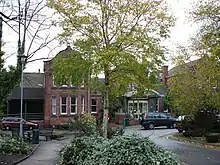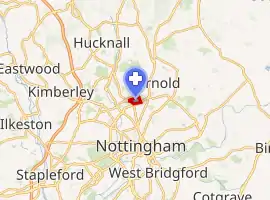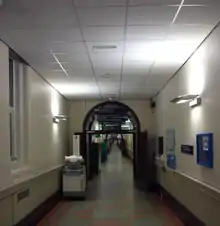Nottingham City Hospital
Nottingham City Hospital is a large hospital located in Nottingham, England. It occupies a large 90-acre (360,000 m2) site on the ring road to the North of the city centre. It is composed of many buildings, most of which are joined together by long corridors. Buildings include a leisure club, a Maggies Centre for people with cancer, and a patient hotel. It is managed by the Nottingham University Hospitals NHS Trust.
| Nottingham City Hospital | |
|---|---|
| Nottingham University Hospitals NHS Trust | |
 North Entrance, Nottingham City Hospital | |

| |
 Shown in Nottinghamshire | |
| Geography | |
| Location | Nottingham, England, United Kingdom |
| Coordinates | 52°59′27″N 1°09′28″W |
| Organisation | |
| Care system | Public NHS |
| Type | Teaching |
| Affiliated university | University of Nottingham |
| Services | |
| Emergency department | No Accident & Emergency |
| Beds | 1100 |
| History | |
| Opened | 1903 |
| Links | |
| Website | www |
| Lists | Hospitals in England |
History

The hospital has its origins in a workhouse built in York Street in 1729 which was demolished to make way for an extension to the Manchester, Sheffield and Lincolnshire Railway in 1895.[1] It re-opened as the Bagthorpe Workhouse and Infirmary on 18 March 1903.[1] It served as a military hospital during the First World War and the Second World War.[2]
The Bagthorpe Infirmary became the City Infirmary in 1930 and the City Hospital in 1937 before joining the National Health Service in 1948.[3] The Nottingham School of Physiotherapy was opened by Group Captain Douglas Bader in 1965.[2] The Bagthorpe Workhouse, which had developed into a facility for the elderly known as Sherwood Hospital, closed as a separate entity in 1983.[4]
The Medical Research Centre was opened by the Duchess of Gloucester in 1986 and a new CT body scanner was unveiled by Princess Margaret in 1988.[2] The Duke of Kent opened the department of clinical radiology and medical physics in 1992 and a new patient hotel came into use in 1994.[2] The Nottingham Breast Institute was opened by Prince Charles in 2004 and a Maggie's Centre was opened by Sir Paul Smith in 2011.[2]
Services
The hospital serves as the regional centre for cancer care, nephrology, infectious diseases, cardiology, cardiothoracic surgery and burns; and is a national centre for shoulder surgery. It also serves as the hyperacute stroke unit, respiratory medicine unit, and elective urology centre for Nottingham. Despite its size, the hospital has never had an Accident and Emergency (A&E) department. It also provides maternity and neonatal facilities.[5]
The hospital has significant roles in teaching and research, in association with the University of Nottingham. Research interests include rheumatology, stroke, respiratory medicine and oncology. Medical students from the University of Nottingham Medical School are attached to most of the departments as part of their clinical training.[6]
See also
References
- Swift, Paul. "The History of the City Hospital Nottingham: A Talk On Its Origins". Visit Nottinghamshire. Retrieved 4 September 2018.
- "Nottingham Hospitals History". Retrieved 4 September 2018.
- "Nottingham City Hospital, Nottingham". National Archives. Retrieved 4 September 2018.
- "Nottingham". Workhouses. Retrieved 4 September 2018.
- "The Labour Suite". Which?. Retrieved 4 September 2018.
- "Routes into Medicine - The University of Nottingham". www.nottingham.ac.uk. Retrieved 29 July 2017.
